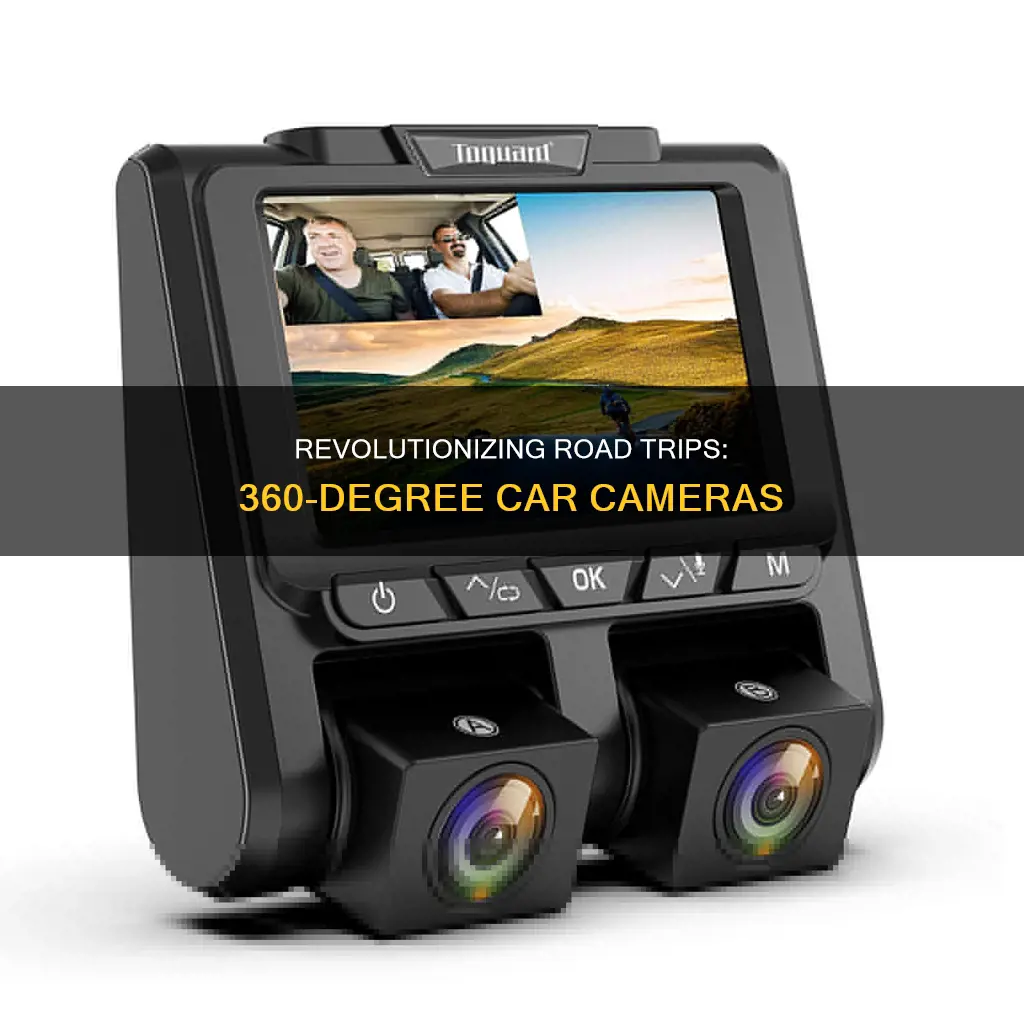
A 360-degree camera system in a car is an advanced safety feature that provides drivers with a real-time view of their surroundings, making it easier to navigate and park. This technology, also known as a Bird's Eye View or Surround View camera system, uses multiple cameras placed around the vehicle to capture a comprehensive view of the car's perimeter. The camera footage is then processed and stitched together to create a single 360-degree image that is displayed on the car's infotainment system, providing drivers with a clear understanding of their surroundings. This system not only enhances parking capabilities but also improves overall safety by eliminating blind spots and providing alerts for nearby objects.
| Characteristics | Values |
|---|---|
| Number of Cameras | 4-6 cameras |
| Camera Placement | Front grille, under side mirrors, rear end, tail, side-view mirrors, bumpers |
| Camera Lenses | Wide-angle |
| Image Processing | Removes distortion, cuts overlapping bits, stitches images together |
| Display | HMI (Human Machine Interface), infotainment system screen |
| Feedback Mechanisms | Audio alerts |
| Proximity Sensors | Ultrasonic/electromagnetic |
| Purpose | Parking assistance, safety, security, off-roading |
What You'll Learn
- The 360-degree camera system is made up of multiple camera arrays placed around the vehicle
- The cameras are installed at strategic points to cover blind spots and give a wide view
- The system's software stitches together images from the different cameras to create a single 360-degree image
- The 360-degree camera is a valuable safety feature, helping drivers stay aware of their surroundings
- Aftermarket 360-degree camera kits are available, but they may not perform as well as factory-installed systems

The 360-degree camera system is made up of multiple camera arrays placed around the vehicle
The 360-degree camera system is an innovative technology that revolutionises the driving experience, providing drivers with a comprehensive view of their surroundings. This system is made possible by strategically placing multiple camera arrays around the vehicle, each capturing a unique perspective. These cameras are typically installed in key locations, such as the front grille, beneath the side mirrors, and at the rear, ensuring maximum coverage.
The magic happens within the vehicle's computer, where advanced software takes centre stage. This software is designed to seamlessly stitch together the individual images from each camera, transforming them into a single, cohesive 360-degree image. The process involves correcting lens distortion, removing overlapping portions, and carefully blending the images to create an uninterrupted view. The result is a crystal-clear, bird's-eye view of the car and its surroundings, projected onto the infotainment system screen.
The placement of these camera arrays is a meticulous process. Engineers spend considerable time simulating CAD models of the vehicle to analyse the field of view and identify blind spots from various angles. This ensures that the cameras are positioned optimally to capture the vehicle's perimeter without compromising aesthetics or functionality. Camera calibration is also crucial, as no two cameras produce identical outputs. Calibration compensates for slight differences in images, ensuring accurate alignment and colour representation.
The 360-degree camera system offers significant advantages, particularly when it comes to parking. With this technology, drivers can effortlessly navigate their vehicle into tight parking spots, avoiding obstacles with precision. Additionally, the system provides a split-screen view, allowing drivers to see both the top view and the front, rear, or side views simultaneously. This enhances situational awareness and makes parking a breeze.
Furthermore, the 360-degree camera is not just a convenience feature but also an important safety measure. By providing a complete surround view, it helps drivers stay alert and aware of their surroundings, reducing the risk of accidents. Some camera systems even offer blind spot monitoring, activating the corresponding side camera when the turn indicators are used, ensuring safer lane changes and turns.
The Camera Lucida's Earliest Days: A Historical Perspective
You may want to see also

The cameras are installed at strategic points to cover blind spots and give a wide view
The 360-degree camera system is a combination of multiple camera arrays placed around the vehicle, providing a bird's-eye view of the car and its surroundings. The cameras are installed at strategic points, typically on the front grille, under the side mirrors, and at the rear of the car, to capture a broad view without obstructing visibility. This setup helps cover blind spots and offers a seamless, cohesive panoramic view, making parking and manoeuvring in tight spaces much safer and easier.
The front camera, usually placed in the grille or on the bumper, clears the path ahead and eliminates blind spots. The rear camera, positioned above or near the license plate, provides a clear view of the area behind the car, including the rear bumper. The side cameras, mounted under the side mirrors or on the vehicle's flanks, offer a clear sight of the blind spots on both sides, ensuring the driver has eyes on every angle.
The cameras in a 360-degree system work together to provide a comprehensive view. The images from each camera are stitched together using image-processing software, creating a single, coherent 360-degree image displayed on the vehicle's infotainment screen or dashboard monitor. This technology enhances driving and parking safety, minimising the risk of accidents and making it easier to navigate in confined spaces.
The 360-degree camera system is an advanced safety feature that has gained popularity in new vehicles. It assists in parking, provides a split-screen view, offers a proximity alert, and improves off-road driving by providing a clear view of obstacles. While it is typically found in higher-end models or as an expensive add-on, some car manufacturers have started including this feature in various segments, making it more accessible to a wider range of drivers.
Charging Camera Batteries: DIY Home Hacks
You may want to see also

The system's software stitches together images from the different cameras to create a single 360-degree image
A 360-degree camera system in a car is an invaluable safety feature, allowing users to stay aware of their surroundings and park safely. This technology is also referred to as a Bird's Eye View or Surround View Camera System. It is a collection of devices that work together to provide the driver with a real-time view of the vehicle's surroundings, projected directly onto the dashboard hardware, usually the infotainment system.
The 360-degree view system uses an array of images received from multiple cameras placed strategically around the car. These cameras are typically installed in the front grille, under the side mirrors, and at the rear of the vehicle. The cameras are positioned to cover the entire perimeter of the vehicle and to provide a wide view that covers blind spots.
The systems software stitches together images from the different cameras to create a single 360-degree image. It removes the distortion caused by wide lenses, cuts out overlapping portions of the images, and combines the images to provide a clear view of the surroundings. The software also adds a graphic of the vehicle and gridlines to provide context and help the driver navigate.
The final image displayed on the infotainment screen may be split to show both the top view and the front/rear/side view simultaneously. This dual-image feature is particularly useful when parallel parking or manoeuvring into a narrow parking space. The system may also include proximity sensors that use ultrasonic or electromagnetic technology to detect the distance to nearby objects. Audio alerts or visual notifications can further assist the driver in avoiding obstacles.
The 360-degree camera system offers several benefits beyond parking assistance. It enables drivers to see angles that rearview or side mirrors cannot provide, enhancing overall situational awareness. Additionally, some vehicles have a blind-spot monitoring system that automatically displays the footage from the side cameras when the turn indicators are activated, facilitating safer lane changes and turns.
In summary, the 360-degree camera system in cars is a sophisticated technology that enhances safety and improves the driving experience. By stitching together images from multiple cameras, the system provides drivers with a comprehensive view of their surroundings, making parking and navigation in tight spaces much easier and reducing the risk of accidents.
Battery-Saving Mode: Impact on Camera Quality
You may want to see also

The 360-degree camera is a valuable safety feature, helping drivers stay aware of their surroundings
The 360-degree camera is an innovative safety feature that revolutionises the driving experience, offering drivers an unparalleled awareness of their surroundings. This advanced technology is a game-changer for parking, manoeuvring, and overall road safety.
The 360-degree camera system is a sophisticated setup that utilises multiple camera arrays strategically placed around the vehicle. These cameras work in tandem with specialised software to provide drivers with a comprehensive, real-time view of their surroundings. By combining footage from different angles, the system offers a bird's-eye view of the car and its vicinity, making it easier for drivers to navigate tight spaces and avoid obstacles.
One of the standout advantages of this technology is its ability to enhance parking accuracy and safety. With the 360-degree view, drivers can easily determine if their car is parked within the guidelines and make adjustments accordingly. The system also enables drivers to see angles that traditional rearview and side mirrors cannot capture, eliminating blind spots and reducing the risk of accidents.
The versatility of the 360-degree camera system extends beyond parking. It can assist drivers when opening doors by checking for sufficient space, and some camera systems even offer blind spot monitoring. This feature alerts drivers to nearby vehicles or obstacles when changing lanes or turning, further enhancing safety.
The effectiveness of the 360-degree camera system lies in its image processing capabilities. The software seamlessly stitches together images from multiple cameras, correcting lens distortion and removing overlapping sections. The resulting composite image provides a crystal-clear, accurate depiction of the car's surroundings. Additionally, proximity sensors further enhance the system's accuracy by evaluating the distance to nearby objects.
In recent years, the 360-degree camera has evolved from a luxury feature to an accessible safety option. Initially reserved for premium cars, it is now offered by almost every automaker across various models, making it more widely available to drivers. While the cost can still be a factor for some, the benefits of improved safety and peace of mind make a compelling case for including this technology in vehicles.
Converting Camera Raw Files to JPEGs: A Step-by-Step Guide
You may want to see also

Aftermarket 360-degree camera kits are available, but they may not perform as well as factory-installed systems
Aftermarket 360-degree camera kits are available for purchase and can be installed in your car. These kits typically include several cameras and a controller that links them to your car's infotainment screen. However, they may not perform as well as factory-installed systems due to several reasons.
Firstly, auto engineers spend a significant amount of time and effort to perfectly position and conceal the cameras within the car's design. They also ensure that the cameras are protected from the environment. This level of precision and integration may be challenging to achieve with an aftermarket kit.
Secondly, factory-installed systems benefit from cameras that are specifically tailored to the make and model of the vehicle. Aftermarket kits, on the other hand, are often designed as a one-size-fits-all solution, which may not provide the same level of compatibility and performance.
Thirdly, the image quality and clarity of an aftermarket 360-degree camera system may not match that of a stock system. This is because automakers invest in advanced software that combines the views from different cameras into seamless, high-resolution images. The result is a clear and undistorted bird's-eye view of the vehicle and its surroundings.
Finally, the installation process for an aftermarket 360-degree camera system can be complex and time-consuming. It requires careful planning, measuring, and calibration to ensure that the cameras are properly positioned and integrated. Improper installation may lead to issues such as non-aligned picture stitching, ghosting, and faulty colour correction.
While aftermarket 360-degree camera kits offer the benefit of adding this technology to vehicles that do not have it as a factory option, they may not be able to match the performance, image quality, and seamless integration of factory-installed systems.
Computer Screens and Cameras: A Jarring Combination?
You may want to see also
Frequently asked questions
A 360-degree camera system uses multiple cameras placed around a car to provide a real-time, bird's-eye view of the vehicle and its surroundings. This helps drivers with parking and manoeuvring by giving them a clearer view of any obstacles.
The system uses an array of images from multiple cameras, typically four or more, installed at strategic points on the car. These include the front grille, under side mirrors, and the rear bumper. The images are then stitched together by image-processing software to create a single, seamless 360-degree image displayed on the vehicle's screen.
The main advantage of this system is improved safety, as it provides drivers with a better view of their surroundings, helping them avoid accidents when parking or changing lanes. It also assists with parking in tight spaces and can offer a split-screen view, showing both the rearview and surround-view images.







